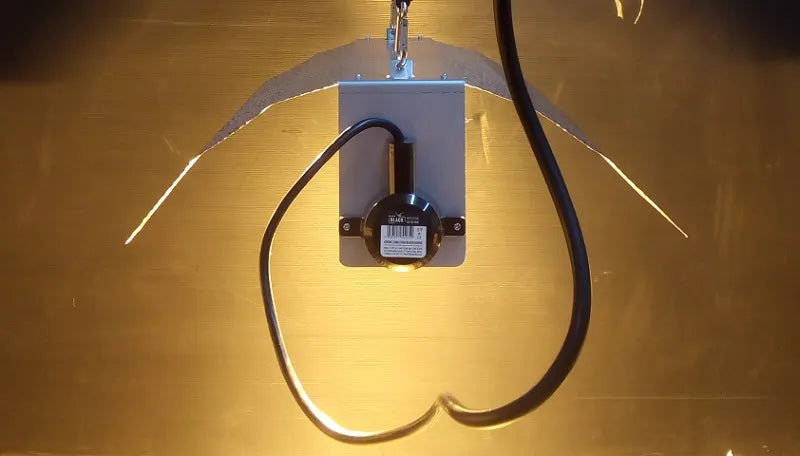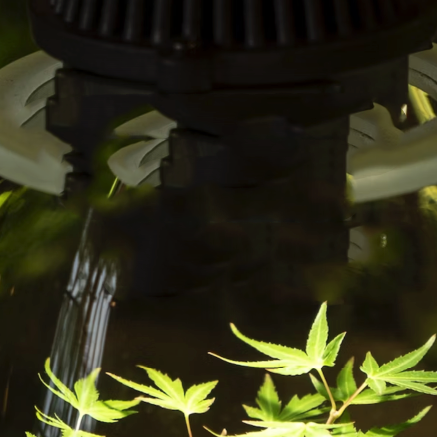Shine a Little Light on Me!
A grow lamp consists of 3 main parts - the ballast, the lamp and the reflector. The job of the ballast is to convert mains electricity into a form that can fire and run a lamp as efficiently as possible. The main differences between different ballasts are whether they are digital or magnetic, if they are dimmable or not, and how many safety features they have. All in all, they do not have the ability to affect a grow to the same extent as lamps and reflectors (unless, perhaps, they have a boost function).
Different grow lamps have different light spectrums and different PAR (photosynthetically active radiation) outputs for a given wattage. Both the spectrum and the brightness have an important effect on plant health and yields. To see the differences between different 600 watt lamps take a look at our grow lamp shootout blog here.
The reflector has at least as much (and maybe more) effect on yields and plant health than the grow lamp.
There's a big choice of reflectors out there. There's all manner of different sizes and shapes to be had. They each have different characteristics mainly how reflective they are, and the shape of the footprint that they throw down. Both of these aspects come into play when it comes down getting the most from a grow lamp and covering a certain size and shape area.
There are several reflectors to be had at the sub-£100 price-point. In this article we will be comparing some of the most popular ones to help you decide which one to go for.
The Euro reflector (often called a "barn" reflector because of its shape) has been the standard budget reflector for so long that it is difficult to remember a time when it wasn't the go-to solution for those a tight budget.
The build is about as simple as it can get. It consists of a rigid L-shaped backbone onto which the rest of the parts are mounted. The angled wings are fitted onto the long part of the L-shape, and the lamp holder is mounted onto the short dropdown at one end. Two prise-up eyelets are located on the long length of the spine for hanging the reflector by. Not much has changed over the years except for the inclusion (by some manufacturers) of a V-shaped reflective part above where the lamp goes.
The wings are not rigid, and many growers "customise" their Euro reflectors by bending the wings up or down. We looked into the effect of this in our Euro reflector wing shape blog here. For this article we tested this reflector as it comes out of box with no bending at all.
Here is the lighting footprint at 24" with a Sylvania Grolux 600 watt lamp over a 1.5m square area:
Keeping with the theme of old stalwarts, a common upgrade from the Euro reflector is the Maxibright Supernova.
Here is the lighting footprint:
Notice how more light is thrown out to the sides which means that the footprint, and therefore the plant growth, will be more even over the larger grow area. The Maxibright Supernova is definitely a worthwhile upgrade over the Euro reflector.
The Adjust-a-Wings range of reflectors has been around quite a while, but they are constantly updated and improved by their inventor, Paul Kronk. With the ability to change the wing width and the height of the lamp holder, we do not know of any other reflector which is as user-configurable or versatile.
The main difference between the Enforcer and the Avenger is the reflectivity of the surface of the wings. The Enforcer, being the cheaper of the two has a reflectivity of 86%. The Avenger is the premium model in the range and boasts a reflectivity of 95-97%. This is down to the use of cutting edge materials and manufacturing techniques. The wings are vapour coated with glass, titanium dioxide and is PVD / ceramic coated.
The Enforcer is available in 3 sizes - small, medium and large. The Avenger is available in 2 sizes - medium and large. Both models cast a very similar footprint, it just that the Avenger is more efficient at returning light back down onto the garden. The size is a choice for the customer but for 600 watt lamp the medium size is perfectly adequate. For 1000 watt lamps the large size would probably be more appropriate.
Here is the lighting footprint for the Avenger with medium settings:
No matter which footprint you look at you can see that the evenness and the spread is superior to the Maxibright Supernova. Having the ability to match the footprint to the grow stage and the grow area is absolutely invaluable for optimising yields. Both of the Adjust-a-Wings reflectors are great but if you can stretch to the Avenger then your garden will definitely benefit from the greater reflectivity.
A parabola is particular shape of curve (a bit like an umbrella-shape) which has some curious properties. A parabola has a point in the middle of it which is called the "focus point". If a reflector has a parabolic shape, then any light produced at the focus point will be reflected straight down. In theory, a parabolic reflector with a lamp placed at the focus point will reflect all the light hitting it from the lamp straight down on to the area directly below it. Of course, the arc-tube inside a lamp (the part that produces the light) is several inches long and some of it will be below the focus point and some of it will be above the focus point. This means that not all the light ends up going straight down and we do end up with some light reaching the area which is not in the area directly beneath it. The Versatile Parabolic Reflector is 95cm in diameter and it allows the user to mount the lamp either vertically or horizontally. Here is the footprint with the lamp mounted vertically:
You can see that almost all of the light has been reflected down onto the circle directly beneath it. Not much light has been cast out to the edges outside of that area. This means that a parabolic reflector (with a vertically mounted lamp) is best used in an area which is not much larger than the diameter of the reflector.
Here is the footprint with the lamp mounted horizontally:
The combination of a parabolic reflector and a horizontally mounted lamp throws down quite an unusual footprint. The light is spread out more to the sides and less concentrated directly below it. This configuration would best be used where the grow area is more than 20-30cm larger than the diameter of the reflector.
Parabolic reflectors are quite large, but they have quite a niche following. Those that swear by them will probably never want to use anything else. There was one other thing that we noticed during testing our versatile parabolic reflector: with the lamp mounted vertically there was much less heat thrown down onto the grow space. This is at least partly due to the inclusion of effective ventilation slots located in the reflector directly above the lamp.
What this comparison shows is that when it comes to grow reflectors you really get what you pay for. It makes solid sense to go for the best one that you can afford. Your yields and returns will certainly benefit.

